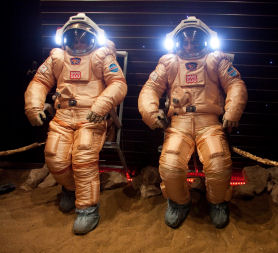Cosmonauts ‘land’ on Mars in virtual space mission
Humans land on Mars – but this time it’s just a shed in Moscow on a 500-day simulated mission. A space expert tells Channel 4 News we may have to wait until the 2040s to see the real thing.

Three crew members of the virtual flight to Mars, run by the European Space Agency, have “landed on the planet” and taken their first steps on the simulated Martian terrain.
It’s the highlight of the 16-month long Mars 500 mission, which is designed to simulate exactly the conditions of astronauts travelling to the Red Planet.
The six crew members have already been in isolated for eight months during the first-ever full-length simulation to Mars – which is housed, for the purposes of this mission, in the Institute of Biomedical Problems in Moscow.
“I can feel how inspiring it will be to look through the eyes of the first human being to step foot on Mars.” Crewmember Diego Urbina
Diego Urbina, one of the first astronauts to step onto the virtual Mars, said: “Europe has for centuries explored Earth, led by people like Columbus and Magellan.
“Today, looking at this red landscape, I can feel how inspiring it will be to look through the eyes of the first human to step foot on Mars. I salute all the explorers of tomorrow and wish them Godspeed.”
Mr Urbina “walked on Mars” with Russian Alexandr Smoleevskiy and Chinese Wang Yue, all wearing spacesuits. The rest of the crew – Romain Charles, Alexey Sitev, and Sukhrob Kamolov – are waiting for them in the “mothership”, as the team took a small lander to the surface.
Tests
The experiment aims to test the physical, medical and psychological effect on the crew of the long isolation. Scientists say the key element of the test will be the dreary eight month return journey, which begins on 1 March, with no highlight like the Mars landing to look forward to.
ESA’s Mars 500 manager Jennifer Ngo-Anh said: “The crew is highly motivated and performing well. The science community is very pleased with the quality of the material but, as this is a long experiment, we have to wait for the results until their ‘arrival’ at Earth. At this point, everything looks very good.”
Mars
Clive Simpson, Editor of Spaceflight magazine, told Channel 4 News the mission was a key step towards a real Mars landing.
“Overall it is a simulation to evaluate what the different stages of a real mission will be like,” he said.
“This will be totally unlike anything mankind has ever undertaken before, because it is such a long-term mission. One of the key things they want to test is how humans will react to the enclosed environment – trying to simulate that, the psychological element, is as important as the technological and scientific.”
“This will be totally unlike anything mankind has ever undertaken before.” Clive Simpson, Spaceflight magazine
While the mission is a preparatory step for a real flight, Mr Simpson said that this could be some years away yet.
“A couple of years ago, if you’d asked me, I would have said we could be looking at a mission to Mars in the 2020s. But as time has slipped by – it’s a very complex mission, very expensive, and there’s a huge amount of risk – I’d say we are looking at at least the late 2030s or 2040s.
“It has got to be politically desirable as well, worldwide,” he said.
“With the global recession people are looking more closely at things – before the mission to Mars I think that we will see a mission to the moon and maybe to an asteroid.”
He said that there was still a “huge question” over whether humans could handle a trip to Mars – which was one of the things the Mars 500 trip is testing.
“And there’s another big question – the radiation in the environment,” he said.
“When you get beyond the moon, towards Mars, there’s radiation – we don’t know how that affects the human body or how to protect it. So there are still big questions. But I think the human spirit is one that will always continue to explore and there will be people willing to take risks, even if the chance of getting back in one piece is very small.”
-
Latest news
-
As India goes to the polls in the world’s largest election – what do British-Indians think?6m

-
Tees Valley: Meet the candidates in one of the biggest contests coming up in May’s local elections4m

-
Keir Starmer says public sector reform will be a struggle7m

-
Nicola Sturgeon’s husband Peter Murrell charged with embezzlement of funds from SNP1m

-
Ukraine might finally get $60billion in American weapons and assistance to defend against Russia3m

-




